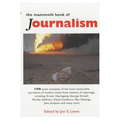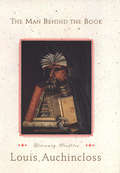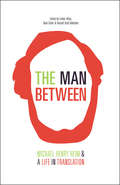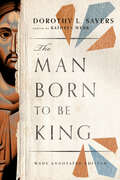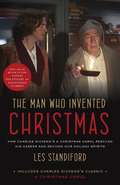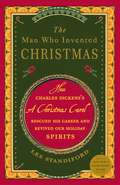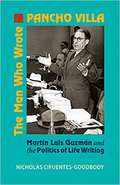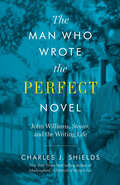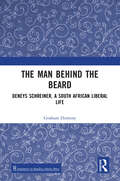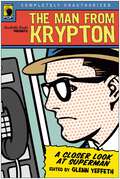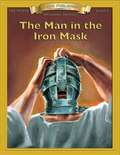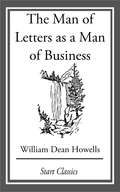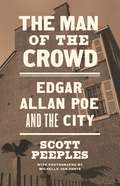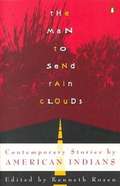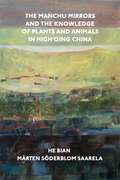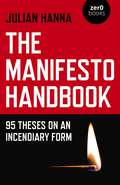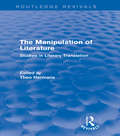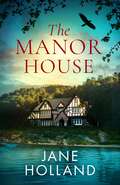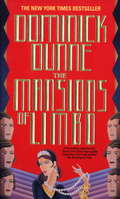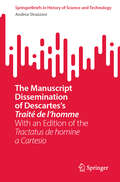- Table View
- List View
The Mammoth Book of Journalism (Mammoth Books #380)
by Jon E. LewisThe newspaper has recorded and influenced modern history like nothing else on earth. From The Washington Post's exposure of Watergate, Tom Wolfe's 1960's social documentary in The Electric Cool-Aid Acid Test to Robert Fisk uncovering the slaugher at Chatila, all the articles included here are reportage from the frontline of life. These are the editorials that have changed our thinking and the criticisms that have penetrated most deeply into contemporary culture. Most of all, they offer a snapshot of these modern times.
The Man Behind the Book: Literary Profiles
by Louis AuchinclossTwenty-three biographical essays on writers admired by the National Medal of Arts–winning author of The Education of Oscar Fairfax.For Louis Auchincloss, life and letters are not two things but one. It therefore comes as no surprise that when he writes about writers, their lives are considered as closely as their works. He takes what today is a refreshingly unpopular position: that the artist and his art cannot be teased apart, that biography of criticism and criticism biography. For Mr. Auchincloss, it all boils down to that maxim of Buffon’s: “the style’s the man,” the man behind the book.The twenty-three writers discussed here are a mixed lot—English, American, and French; novelists, poets, and playwrights; Jacobeans, Victorians, and moderns—yet each has meant a great deal to Mr. Auchincloss as a reader and a writer. Some of them are classics, and familiar Auchincloss subjects: Sarah Orne Jewett, Henry James, Ivy Compton-Burnett. Others, among them Prosper Merimee, Harold Frederic, and Amy Lowell, were famous once but are now obscure. In their cases it is Mr. Auchincloss’s self-described task “to explore the reasons for their fall from grace,” reasons that prove to be unfailingly personal as well as artistic. But as Mr. Auchincloss would rather praise and share than damn and dismiss, it is also his task “to seek the portions of their work that may still merit attention.”Alfred Kazin once noted that Mr. Auchincloss’s essays are marked by “perfect literary grace and wit.” These qualities have never been so evident as in this volume, an informal study of some of the author's favorite books and the fascinating artists behind them.
The Man Between
by Michael Henry Heim Sean Cotter Esther Allen Russell Scott ValentinoWhen Michael Henry Heim--one of the most respected translators of his generation--passed away in the fall of 2012, he left behind an astounding legacy. Over his career, he translated two-dozen works from eight different languages, including books by Milan Kundera, Dubravka Ugresic, Hugo Claus, and Anton Chekov.But Mike, as he was known to his legion of friends, was much more than that. His classes at UCLA on translation inspired a new generation of translators, and his work altering the way translation is viewed in the university will impact the livelihood of translators for decades to come.If that weren't enough, upon his death it was revealed that Heim was the anonymous donor responsible for the PEN Translation Fund--the largest fund in America supporting up-and-coming translators.Hundreds of people in the literary community were impacted by Heim's life and actions, and this book is a small way of honoring this quiet, humble man who, among many other things, is responsible for the title The Unbearable Lightness of Being (and all its variants) entering the English idiom.Comprising a number of different sections--a short autobiography, pieces from authors he worked with, worksheets detailing his teaching and translation techniques--The Man Between opens a window onto the life and teachings of Michael Henry Heim, and, similar to David Bellos's Is That a Fish in Your Ear?, will be of great interest to anyone interested in language, international culture, and the art of translation.
The Man Born to Be King: Wade Annotated Edition
by Dorothy L. SayersFrom December 1941 until October 1942, the BBC broadcast a series of radio dramas written by Dorothy L. Sayers.Noted for their use of colloquial English as part of Sayers's effort to bring the Gospels to life in a new way for listeners, the plays were both controversial and incredibly successful, bolstering the morale of the country during the war. They were subsequently published in 1943, and they stand among Sayers's most beloved works to this day.In this new critical and annotated edition, scholar Kathryn Wehr brings fresh insights to the plays, their background, Sayers's creative process, and the ongoing significance of the life of Christ today. Listen again, or for the first time, to the story of the man who was born to be—and still is—king.
The Man Who Invented Christmas (Movie Tie-In): How Charles Dickens's A Christmas Carol Rescued His Career and Revived Our Holiday Spirits
by Les StandifordAs uplifting as the tale of Scrooge itself, this is the story of how Charles Dickens revived the signal holiday of the Western world. Soon to be a major motion picture. Just before Christmas in 1843, a debt-ridden and dispirited Charles Dickens wrote a small book he hoped would keep his creditors at bay. His publisher turned it down, so Dickens used what little money he had to put out A Christmas Carol himself. He worried it might be the end of his career as a novelist. The book immediately caused a sensation. And it breathed new life into a holiday that had fallen into disfavor, undermined by lingering Puritanism and the cold modernity of the Industrial Revolution. It was a harsh and dreary age, in desperate need of spiritual renewal, ready to embrace a book that ended with blessings for one and all. With warmth, wit, and an infusion of Christmas cheer, Les Standiford whisks us back to Victorian England, its most beloved storyteller, and the birth of the Christmas we know best. The Man Who Invented Christmas is a rich and satisfying read for Scrooges and sentimentalists alike.
The Man Who Invented Christmas: How Charles Dickens's A Christmas Carol Rescued His Career and Revived Our Holiday Spirits
by Les StandifordAs uplifting as the tale of Scrooge itself, this is the story of how one writer and one book revived the signal holiday of the Western world.Just before Christmas in 1843, a debt-ridden and dispirited Charles Dickens wrote a small book he hoped would keep his creditors at bay. His publisher turned it down, so Dickens used what little money he had to put out A Christmas Carol himself. He worried it might be the end of his career as a novelist.The book immediately caused a sensation. And it breathed new life into a holiday that had fallen into disfavor, undermined by lingering Puritanism and the cold modernity of the Industrial Revolution. It was a harsh and dreary age, in desperate need of spiritual renewal, ready to embrace a book that ended with blessings for one and all.With warmth, wit, and an infusion of Christmas cheer, Les Standiford whisks us back to Victorian England, its most beloved storyteller, and the birth of the Christmas we know best. The Man Who Invented Christmas is a rich and satisfying read for Scrooges and sentimentalists alike.From the Hardcover edition.
The Man Who Loved Books Too Much: The True Story of a Thief, a Detective, and a World of Literary Obsession
by Allison Hoover BartlettThis is the story of John Gilkey, a man who repeatedly stole rare books, and the journalist who tells of, and gets caught up in, his exploits.
The Man Who Wrote Pancho Villa: Martin Luis Guzman and the Politics of Life Writing
by Nicholas Cifuentes-GoodbodyMartin Luis Guzman was many things throughout his career in twentieth-century Mexico: a soldier in Pancho Villa's revolutionary army, a journalist-in-exile, one of the most esteemed novelists and scholars of the revolutionary era, and an elder statesman and politician. In The Man Who Wrote Pancho Villa, we see the famous author as he really was: a careful craftsman of his own image and legacy. His five-volume biography of Villa propelled him to the heights of Mexican cultural life, and thus began his true life's work. Nicholas Cifuentes-Goodbody shapes this study of Guzman through the lens of "life writing" and uncovers a tireless effort by Guzman to shape his public image.The Man Who Wrote Pancho Villa places Guzman's work in a biographical context, shedding light on the immediate motivations behind his writing in a given moment and the subsequent ways in which he rewrote or repackaged the material. Despite his efforts to establish a definitive reading of his life and literature, Guzman was unable to control that interpretation as audiences became less tolerant of the glaring omissions in his self-portrait.
The Man Who Wrote Pancho Villa: Martin Luis Guzman and the Politics of Life Writing
by Nicholas Cifuentes-GoodbodyMartin Luis Guzman was many things throughout his career in twentieth-century Mexico: a soldier in Pancho Villa's revolutionary army, a journalist-in-exile, one of the most esteemed novelists and scholars of the revolutionary era, and an elder statesman and politician. In The Man Who Wrote Pancho Villa, we see the famous author as he really was: a careful craftsman of his own image and legacy. His five-volume biography of Villa propelled him to the heights of Mexican cultural life, and thus began his true life's work. Nicholas Cifuentes-Goodbody shapes this study of Guzman through the lens of "life writing" and uncovers a tireless effort by Guzman to shape his public image.The Man Who Wrote Pancho Villa places Guzman's work in a biographical context, shedding light on the immediate motivations behind his writing in a given moment and the subsequent ways in which he rewrote or repackaged the material. Despite his efforts to establish a definitive reading of his life and literature, Guzman was unable to control that interpretation as audiences became less tolerant of the glaring omissions in his self-portrait.
The Man Who Wrote the Perfect Novel: John Williams, Stoner, and the Writing Life
by Charles J. ShieldsAn &“engrossing&” biography of a brilliant novelist underappreciated in his own time who became a twenty-first-century bestseller, from the New York Times–bestselling author (The New Yorker). When Stoner was published in 1965, the novel sold only a couple of thousand copies before disappearing with hardly a trace. Yet the quietly powerful tale of Midwestern college professor William Stoner, whose life becomes a parable of solitude and anguish, eventually found an admiring audience in America and especially in Europe. The New York Times called Stoner &“a perfect novel,&” and a host of writers and critics, including Colum McCann, Julian Barnes, Bret Easton Ellis, Ian McEwan, Emma Straub, Ruth Rendell, C.P. Snow, and Irving Howe, praised its artistry. The New Yorker deemed it &“a masterly portrait of a truly virtuous and dedicated man.&” This biography traces the life of Stoner&’s author, John Williams. Charles J. Shields follows the whole arc of Williams&’s life, which in many ways paralleled that of his titular character, from their shared working-class backgrounds to their undistinguished careers in academia. Shields vividly recounts Williams&’s development as an author, whose other works include the novels Butcher&’s Crossing and Augustus (for the latter, Williams shared the 1972 National Book Award). Shields also reveals the astonishing afterlife of Stoner, which garnered new fans with each American reissue, and then became a bestseller all over Europe after a Dutch publisher brought out a translation in 2013. Since then, Stoner has been published in twenty-one countries and sold over a million copies. &“Like Williams, Shields know how to tell a good story, one that will appeal especially to those interested in the ins and outs of the publishing industry and the ups and downs of a writer&’s life.&” —Los Angeles Review of Books
The Man Who Wrote the Perfect Novel: John Williams, Stoner, and the Writing Life
by Charles J. ShieldsAn &“engrossing&” biography of a brilliant novelist underappreciated in his own time who became a twenty-first-century bestseller, from the New York Times–bestselling author (The New Yorker). When Stoner was published in 1965, the novel sold only a couple of thousand copies before disappearing with hardly a trace. Yet the quietly powerful tale of Midwestern college professor William Stoner, whose life becomes a parable of solitude and anguish, eventually found an admiring audience in America and especially in Europe. The New York Times called Stoner &“a perfect novel,&” and a host of writers and critics, including Colum McCann, Julian Barnes, Bret Easton Ellis, Ian McEwan, Emma Straub, Ruth Rendell, C.P. Snow, and Irving Howe, praised its artistry. The New Yorker deemed it &“a masterly portrait of a truly virtuous and dedicated man.&” This biography traces the life of Stoner&’s author, John Williams. Charles J. Shields follows the whole arc of Williams&’s life, which in many ways paralleled that of his titular character, from their shared working-class backgrounds to their undistinguished careers in academia. Shields vividly recounts Williams&’s development as an author, whose other works include the novels Butcher&’s Crossing and Augustus (for the latter, Williams shared the 1972 National Book Award). Shields also reveals the astonishing afterlife of Stoner, which garnered new fans with each American reissue, and then became a bestseller all over Europe after a Dutch publisher brought out a translation in 2013. Since then, Stoner has been published in twenty-one countries and sold over a million copies. &“Like Williams, Shields know how to tell a good story, one that will appeal especially to those interested in the ins and outs of the publishing industry and the ups and downs of a writer&’s life.&” —Los Angeles Review of Books
The Man behind the Beard: Deneys Schreiner, a South African Liberal Life
by Graham DominyDeneys Schreiner was an academic, a scientist and a man of strong liberal principles, with a good sense of humor and widespread interests in the sciences, arts and public affairs. In his steady way, he transformed the University of Natal and the community around it. Between the 1960s and 1980s, Schreiner supported and initiated several endeavors to promote constitutional futures other than those imposed by the apartheid government. One of the most significant was the Buthelezi Commission, which he chaired. This biography sets out the context of the times in which Schreiner lived and his life from his ancestors to his tenure as Vice-Principal. This book is created with extensive archival research, supported by interviews with family members, former colleagues, friends, and journalists. Schreiner was a man who made a considerable contribution to the struggle for democracy in South Africa. And then there is the story of his beard, once described as a potent symbol of his presence and implacable integrity. Print edition not for sale in Sub Saharan Africa.
The Man from Krypton: A Closer Look at Superman
by Glenn YeffethLeading writers discuss, debate, and celebrate the legend of Superman in this anthology, contending that his legend is a truly American myth. Superman was an immigrant with little more than the clothes on his back and raised by simple farmers, absorbing their humble values. He always chose to do the right thing, fighting for truth, justice, and the American way, and represents America at its best. The in-depth analyses of the comics, films and cartoons are at turns funny, philosophical, insightful, and personal, exploring every aspect of the Superman legend.
The Man in the Iron Mask
by Alexandre Dumas Robin M. AionaBring the Classics To Life. These novels have been adapted into 10 short chapters that will excite the reluctant reader as well as the enthusiastic one. Key words are defined and used in context. Multiple-choice questions require the student to recall specific details, sequence the events, draw inferences from story context, develop another name for the chapter, and choose the main idea.
The Man of Letters as a Man of Busine
by William Dean HowellsHe can say that, as the thing is, unless he sells his art he cannot live, that society will leave him to starve if he does not hit its fancy in a picture, or a poem, or a statue; and all this is bitterly true. He is, and he must be, only too glad if there is a market for his wares.
The Man of the Crowd: Edgar Allan Poe and the City
by Scott PeeplesHow four American cities shaped Poe's life and writingsEdgar Allan Poe (1809–1849) changed residences about once a year throughout his life. Driven by a desire for literary success and the pressures of supporting his family, Poe sought work in American magazines, living in the cities that produced them. Scott Peeples chronicles Poe's rootless life in the cities, neighborhoods, and rooms where he lived and worked, exploring how each new place left its enduring mark on the writer and his craft.Poe wrote short stories, poems, journalism, and editorials with urban readers in mind. He witnessed urban slavery up close, living and working within a few blocks of slave jails and auction houses in Richmond and among enslaved workers in Baltimore. In Philadelphia, he saw an expanding city struggling to contain its own violent propensities. At a time when suburbs were just beginning to offer an alternative to crowded city dwellings, he tried living cheaply on the then-rural Upper West Side of Manhattan, and later in what is now the Bronx. Poe's urban mysteries and claustrophobic tales of troubled minds and abused bodies reflect his experiences living among the soldiers, slaves, and immigrants of the American city.Featuring evocative photographs by Michelle Van Parys, The Man of the Crowd challenges the popular conception of Poe as an isolated artist living in a world of his own imagination, detached from his physical surroundings. The Poe who emerges here is a man whose outlook and career were shaped by the cities where he lived, longing for a stable home.
The Man to Send Rain Clouds: Contemporary Stories by American Indians
by Kenneth RosenThe stories in this collection--now updated with a new introduction--reflect the modern experience of white-educated Indians, bitterly aware that their culture is threatened with destruction, trying to bear witness through a non-Indian genre: the short story.
The Management Of Cultural World Heritage Sites and Development In Africa
by Simon MakuvazaEver since the signing of the World Heritage Convention 40 years ago and ratified by 33 African countries, to date, only 43 cultural heritage sites have been successfully proclaimed as World Heritage Sites in Africa. These include archaeological and historical sites, religious monuments and cultural landscapes This book is a re-evaluation of the nomination and management of cultural World Heritage sites in Africa from the late 1970s when the Island of Gorée of Senegal and the Rock-Hewn Churches of Ethiopia were first inscribed on the WHL until today It considers whether a credible and well balanced WHL has been attained, especially in regards to the nomination of more sites in Africa. The book also examines the roles and contribution of various heritage organizations and African governments to the nomination and management of cultural World Heritage sites in Africa. Lastly, the volume also scrutinizes economic development, which may result from the nomination and successful management of cultural World Heritage sites in Africa.
The Manchu Mirrors and the Knowledge of Plants and Animals in High Qing China (Harvard-Yenching Institute Monograph Series #143)
by He Bian Mårten Söderblom SaarelaAs the territory of Qing China expanded, so evolved the ways in which birds, beasts, fish, trees, and flowers came to be known in the multilingual empire. The Manchu Mirrors and the Knowledge of Plants and Animals in High Qing China is the first systematic study of how the Qing court sought to codify Manchu and Chinese words for animals and plants throughout the eighteenth century, with a particular focus on Manchurian and other Inner Asian species. Calling for renewed attention to Manchu dictionaries as an important source for Qing intellectual and cultural history, Bian and Söderblom Saarela show how Qing lexicographical practices embodied major revisions to the Chinese encyclopedic tradition, realigned the relationship between words and things, and left a lasting impact on natural historical scholarship in the modern era. The updated form of Chinese learning, along with the malleable lexicon of the Manchu language, proved useful for the Manchu elite in displaying the reach and intellectual depth of Qing imperial power. Manchu was transformed from the language of a single people into the lexicographic façade for an imperial order of things.
The Manifesto Handbook: 95 Theses on an Incendiary Form
by Julian HannaThe Manifesto Handbook describes the hidden life of an undervalued genre: the conduit for declarations of principle, advertisements for new &“isms,&” and provocations in pamphlet form. Often physically slight and small in scale, the manifesto is always grand in style and ambition. A bold, charismatic genre, it has founded some of the most important and revolutionary movements in modern history, from the declaration of wars and the birth of nations to the launch of countless social, political and artistic movements worldwide. Julian Hanna provides a brief genealogy of the genre, analyses its complex speaking position, traces the material process of manifesto making from production to dissemination, unpacks its extremist underbelly, and follows the twenty-first century resurgence of the manifesto as a re-politicised and reinvigorated digital form.
The Manipulation of Literature: Studies in Literary Translation (Routledge Revivals)
by Theo HermansFirst published in 1985, the essays in this edited collection offer a representative sample of the descriptive and systematic approach to the study of literary translation. The book is a reflection of the theoretical thinking and practical research carried out by an international group of scholars who share a common standpoint. They argue the need for a rigorous scientific approach the phenomena of translation – one of the most significant branches of Comparative Literature – and regard it as essential to link the study of particular translated texts with a broader methodological position. Considering both broadly theoretical topics and particular cases and traditions, this volume will appeal to a wide range of students and scholars across disciplines.
The Manor House
by Jane Holland'I absolutely love this book from start to finish...a really atmospheric read, and brilliant characters.' NetGalley Reader, *****1963. When Eleanor meets famous young poet, Lyndon Chance, he offers a way to flee her abusive father. In return, she must pretend to be Lyndon's wife. He takes her home to a Tudor manor on the Camel Estuary in Cornwall, where she finds herself in the middle of a feud between Lyndon and his twin brother, Oliver. It's soon clear that the old house hides many dark secrets. But could they be a threat to Eleanor?Now. Taylor has come to idyllic Cornwall to research for her Master's thesis, combining her love for conservation with a personal interest in Chance's poetry. Haunted by her own tragic past, Taylor finds Chance's notoriety fascinating. If only the poet's grandson, Julius, wasn't so determined to thwart her attempts to uncover his family secrets. As Eleanor realises she's out of her depth at Estuary House, drawn to Lyndon like a moth to a flame, Taylor and Julius must fight their own attraction - but could shadows from the past tear them all apart?A stunning and richly evocative timeslip, perfect for fans of Lucinda Riley, Santa Montefiore and Kate Morton.
The Manor House
by Jane Holland'I absolutely love this book from start to finish...a really atmospheric read, and brilliant characters.' NetGalley Reader, *****1963. When Eleanor meets famous young poet, Lyndon Chance, he offers a way to flee her abusive father. In return, she must pretend to be Lyndon's wife. He takes her home to a Tudor manor on the Camel Estuary in Cornwall, where she finds herself in the middle of a feud between Lyndon and his twin brother, Oliver. It's soon clear that the old house hides many dark secrets. But could they be a threat to Eleanor?Now. Taylor has come to idyllic Cornwall to research for her Master's thesis, combining her love for conservation with a personal interest in Chance's poetry. Haunted by her own tragic past, Taylor finds Chance's notoriety fascinating. If only the poet's grandson, Julius, wasn't so determined to thwart her attempts to uncover his family secrets. As Eleanor realises she's out of her depth at Estuary House, drawn to Lyndon like a moth to a flame, Taylor and Julius must fight their own attraction - but could shadows from the past tear them all apart?A stunning and richly evocative timeslip, perfect for fans of Lucinda Riley, Santa Montefiore and Kate Morton.
The Mansions of Limbo
by Dominick DunneIn a collection of his essays from Vanity Fair, the best-selling author reveals the life and times of the beautiful--and not-so-beautiful--people.
The Manuscript Dissemination of Descartes’s Traité de l’homme: With an Edition of the Tractatus de homine a Cartesio (SpringerBriefs in History of Science and Technology)
by Andrea StrazzoniThis book offers the first thorough-going account of the covert manuscript dissemination of a pivotal text in the history of early modern philosophy and science, namely the Traité de l’homme by René Descartes, completed in 1633 but published in printed form only in 1662 and 1664. This account serves as both introduction to and commentary upon the following transcription of a Latin handwritten translation of the treatise (Tractatus de homine a Cartesio) recently brought to the attention of scholars, and which was integral to such dissemination. Included is an apparatus of variants with respect to its first editions. Importantly, during its first dissemination the treatise fostered the development of medical theories based on mechanical ideas and is now increasingly at the centre of the attention of historians, thanks to the renewed appreciation of Descartes as a scientist rather than as a metaphysician. By developing an investigation taking into account not only professors and scientists, but also the importance of women, courtiers, publishers, soldiers, and the covert circulation of knowledge in the early modern age, this book contributes to the knowledge of scholars, students, and anybody interested in the early modern history of philosophy, science, intellectual history, and the history of the book in a crucial phase of the development of western thought.
